Numerical Investigations on the Influencing Factors of Rapid Fire Spread of Flammable Cladding in a High-Rise Building
Abstract
:1. Introduction
2. Numerical Model Development and Verification
2.1. Test Data Collection
2.2. Numerical Model Development
2.2.1. Geometry Modelling
2.2.2. Material Properties Used in Modelling
2.2.3. Fire Load Used in Modelling
2.2.4. Grid Sensitivity
2.3. Numerical Model Validation with Test Data
2.3.1. External Thermocouples at Level 1
2.3.2. External Thermocouples at Level 2
2.3.3. Visual Observation
2.4. Parametric Analysis
3. Results and Discussion
3.1. Effect of Cavity Barrier
3.2. Effect of Air-Cavity Gap
3.3. Effect of Joining Gaps between ACP Panels
3.4. Effect of Combustible Cladding
4. Conclusions
- In order to acquire a conservative fire risk estimate during full-scale testing, cavity barriers need to be installed. The exterior temperature test output displayed fewer conservative values without a cavity barrier than it did with a barrier.
- Due to the effective chimney effect, air cavities between 50 and 100 mm demonstrated a greater potential for rapid fire propagation. Therefore, these parameters can be used as a conservative assembly setup for testing purposes.
- The joining between the cladding panels can act as a vehicle for rapid fire spread, especially through the internal cavity.
- The external temperature criteria for accessing the failure criterion of the ACPs were found to be more consistent with different parametric variables so this needs to be given more importance during fire test assessments.
Author Contributions
Funding
Conflicts of Interest
References
- Hossain, M.D.; Hassan, M.K.; Yuen, A.C.Y.; He, Y.; Saha, S.; Hittini, W. Flame behaviour, fire hazard and fire testing approach for lightweight composite claddings—A review. J. Struct. Fire Eng. 2021, 12, 257–292. [Google Scholar] [CrossRef]
- Hossain, M.D.; Saha, S.; Hassan, M.K.; Yuen, A.C.Y.; Wang, C.; Hittini, W.; George, L.; Wuhrer, R. Testing of aluminium composite panels in a cone calorimeter: A new specimen preparation method. Polym. Test. 2022, 106, 107454. [Google Scholar] [CrossRef]
- White, N.; Delichatsios, M. Fire Hazards of Exterior Wall Assemblies Containing Combustible Components; Springer: Cham, Switzerland, 2015. [Google Scholar]
- Chen, T.; Yuen, A.; Yeoh, G.; Yang, W.; Chan, Q. Fire risk assessment of combustible exterior cladding using a collective numerical database. Fire 2019, 2, 11. [Google Scholar] [CrossRef]
- Hossain, M.D.; Hassan, M.K.; Akl, M.; Pathirana, S.; Rahnamayiezekavat, P.; Douglas, G.; Bhat, T.; Saha, S. Fire Behaviour of Insulation Panels Commonly Used in High-Rise Buildings. Fire 2022, 5, 81. [Google Scholar] [CrossRef]
- Hossain, M.D.; Saha, S.; Hassan, M.K.; Yuen, A.C.Y.; Wang, C.; Hittini, W. Influencing factors in small-scale fire testing of aluminium composite panels. In Proceedings of the 12th Asia-Oceania Symposium on Fire Science and Technology (AOSFST), Brisbane, Australia, 7–9 December 2021. [Google Scholar]
- Genco, G. Lacrosse Building Fire Report, 2015. Available online: https://www.melbourne.vic.gov.au/sitecollectiondocuments/mbs-report-lacrosse-fire.pdf (accessed on 22 May 2022).
- Bisby, L.A. Grenfell Tower Inquiry: Phase 1—Final Expert Report; Grenfell Tower Enquiry: London, UK, 2018. [Google Scholar]
- NFPA 285; Standard Fire Test Method for Evaluation of Fire Propagation Characteristics of Exterior Non-Load-Bearing Wall Assemblies Containing Combustible Components. National Fire Protection Association: Quincy, MA, USA, 2019.
- ISO 13785-2:2002; Reaction-to-Fire Tests for Façades—Part 2: Large-Scale Test. ESA: Addis Abeba, Ethiopia, 2002.
- BS 8414-1; Fire Performance of External Cladding Systems. Test Methods for Non-Loadbearing External Cladding Systems Applied to the Face of a Building. British Standard: London, UK, 2002.
- AS 5113:2016; Fire Propagation Testing and Classification of External Walls of Buildings. Standards Australia: Sydney, Australia, 2016.
- Schulz, J.; Kent, D.; Crimi, T.; Glockling, J.L.; Hull, T.R. A Critical Appraisal of the UK’s regulatory regime for combustible façades. Fire Technol. 2021, 57, 261–290. [Google Scholar] [CrossRef]
- Čolić, A.; Pečur, I.B. Influence of Horizontal and Vertical Barriers on Fire Development for Ventilated Façades. Fire Technol. 2020, 56, 1725–1754. [Google Scholar] [CrossRef]
- Sharma, A.; Mishra, K.B. Experimental investigations on the influence of ‘chimney-effect’on fire response of rainscreen façades in high-rise buildings. J. Build. Eng. 2021, 44, 103257. [Google Scholar] [CrossRef]
- Agarwal, G. Research Technical Report: Evaluation of the Fire Performance of Aluminum Composite Material (ACM) Assemblies Using ANSI/FM 4880; FM Global: Norwood, MA, USA, 2017. [Google Scholar]
- DCLG. DCLG, BS 8414-1:2015 + A1:2017 Test Referred to as DCLG Test 1, BRE Global, 2017. Available online: https://www.nfpa.org/-/media/Files/News-and-Research/Publications-and-media/NFPA-Journal/2017/September-October-2017/BRE-test.ashx (accessed on 22 June 2022).
- Heat Conduction in Pyrosim. Available online: https://support.thunderheadeng.com/tutorials/pyrosim/heat-conduction/ (accessed on 20 July 2022).
- Chaudhari, D.M.; Stoliarov, S.I.; Beach, M.W.; Suryadevara, K.A. Polyisocyanurate Foam Pyrolysis and Flame Spread Modeling. Appl. Sci. 2021, 11, 3463. [Google Scholar] [CrossRef]
- Bonner, M.; Rein, G. Flammability and multi-objective performance of building façades: Towards optimum design. Int. J. High-Rise Build. 2018, 7, 363–374. [Google Scholar]
- Dréan, V.; Girardin, B.; Guillaume, E.; Fateh, T. Numerical simulation of the fire behaviour of facade equipped with aluminium Composite material-based claddings—Model validation at intermediate scale. Fire Mater. 2019, 43, 839–856. [Google Scholar] [CrossRef]
- Dréan, V.; Girardin, B.; Guillaume, E.; Fateh, T. Numerical simulation of the fire behaviour of facade equipped with aluminium composite material-based claddings—Model validation at large scale. Fire Mater. 2019, 43, 981–1002. [Google Scholar] [CrossRef] [Green Version]
- Lyon, R.; Janssens, M. DOT/FAA/AR-05/14; Polymer Flammability. National Technical Information Service: Springfield, VA, USA, 2005.
- Purser, D.A. Toxic combustion product yields as a function of equivalence ratio and flame retardants in under-ventilated fires: Bench-large-scale comparisons. Polymers 2016, 8, 330. [Google Scholar] [CrossRef] [PubMed]
- Marquis, D.M.; Hermouet, F.; Guillaume, É. Effects of reduced oxygen environment on the reaction to fire of a poly (urethane-isocyanurate) foam. Fire Mater. 2017, 41, 245–274. [Google Scholar] [CrossRef]
- EN 1999-1-2; Eurocode 9—Design of Aluminium Structures—Part 1–2: Structural Fire Design. European Committee for Standardization: Brussels, Belgium, 2007.
- Petterson, N.M. Assessing the Feasibility of Reducing the Grid Resolution in FDS Field Modelling; University of Cantenbury: Christchurch, New Zealand, 2002. [Google Scholar]

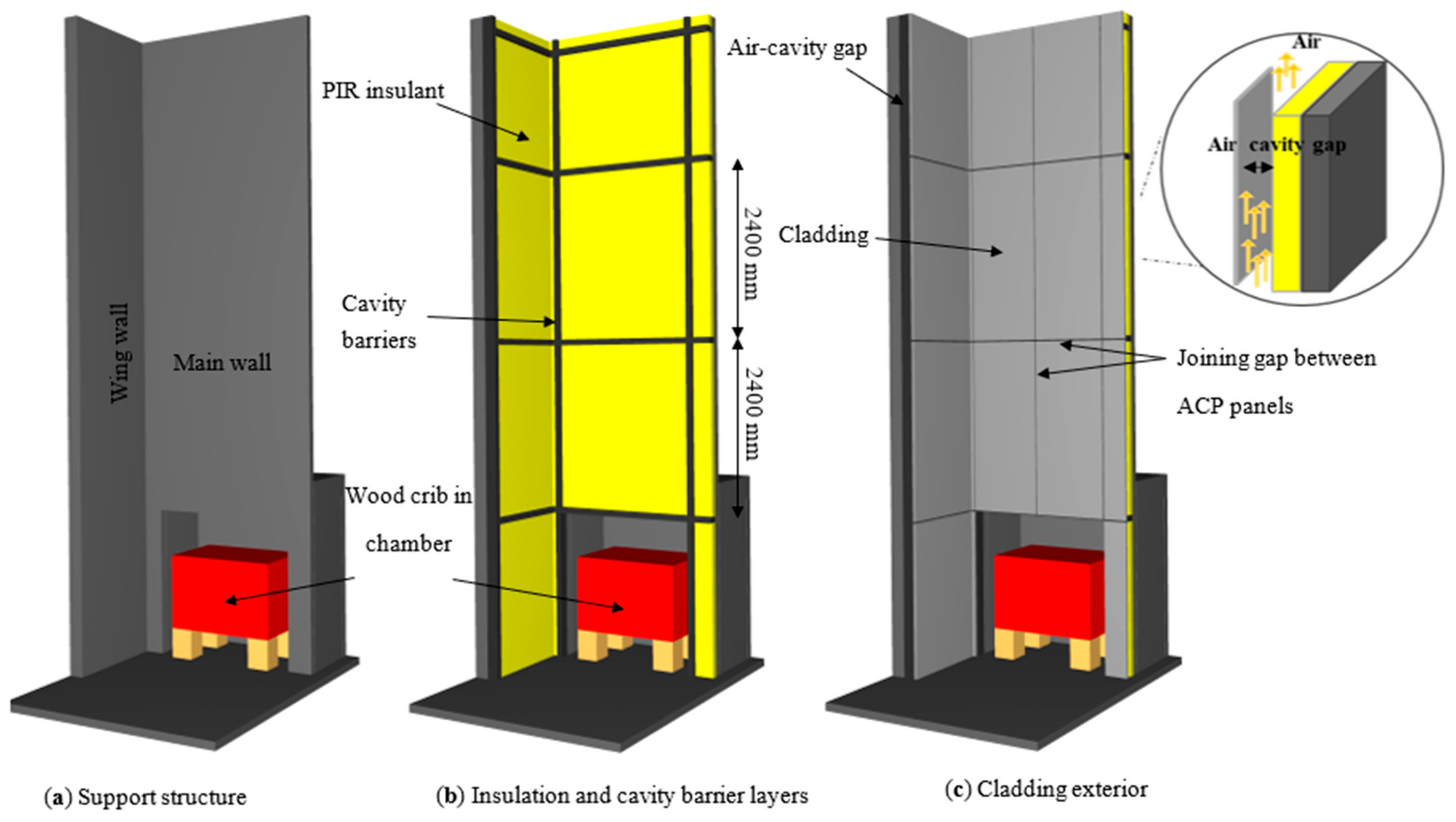
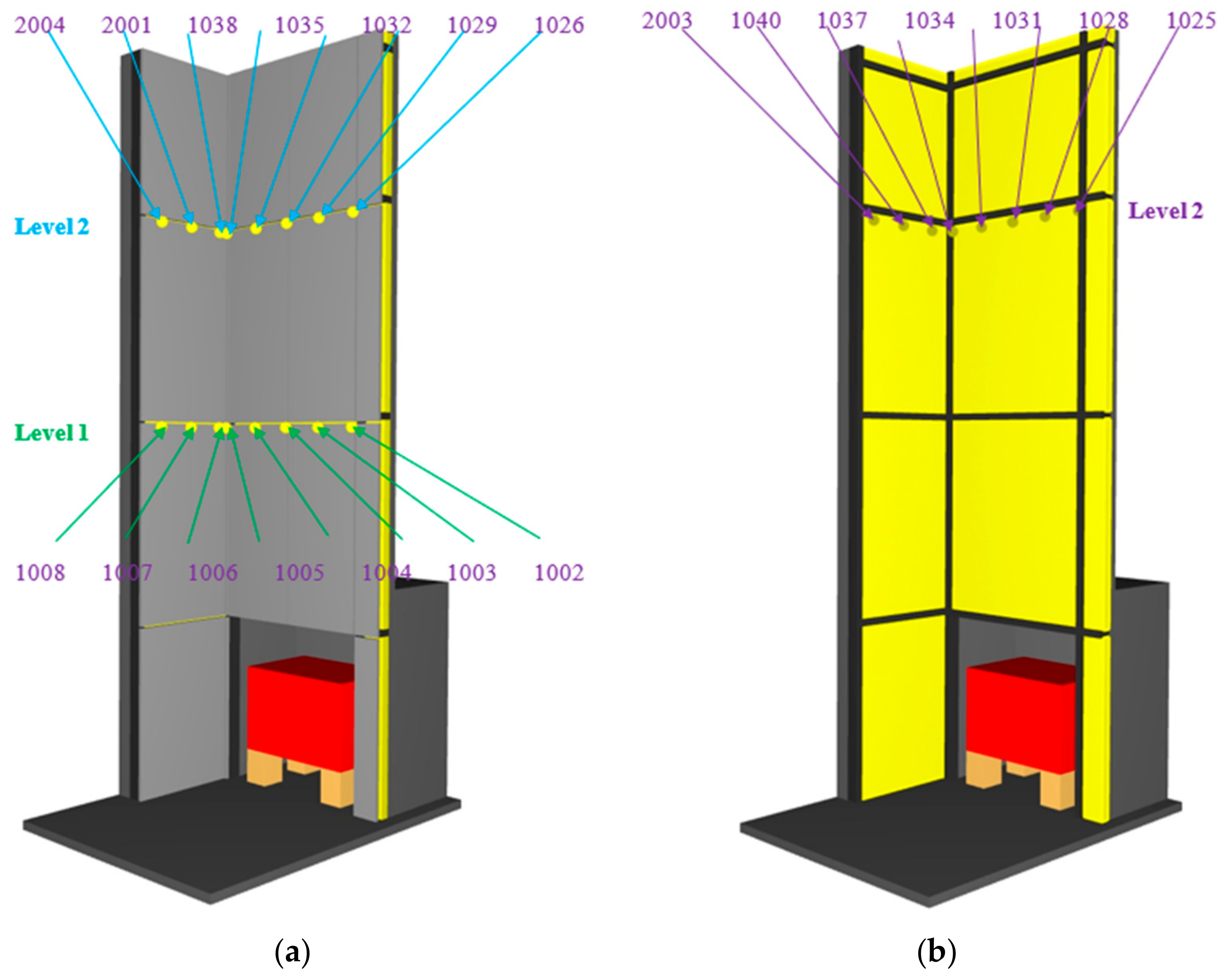
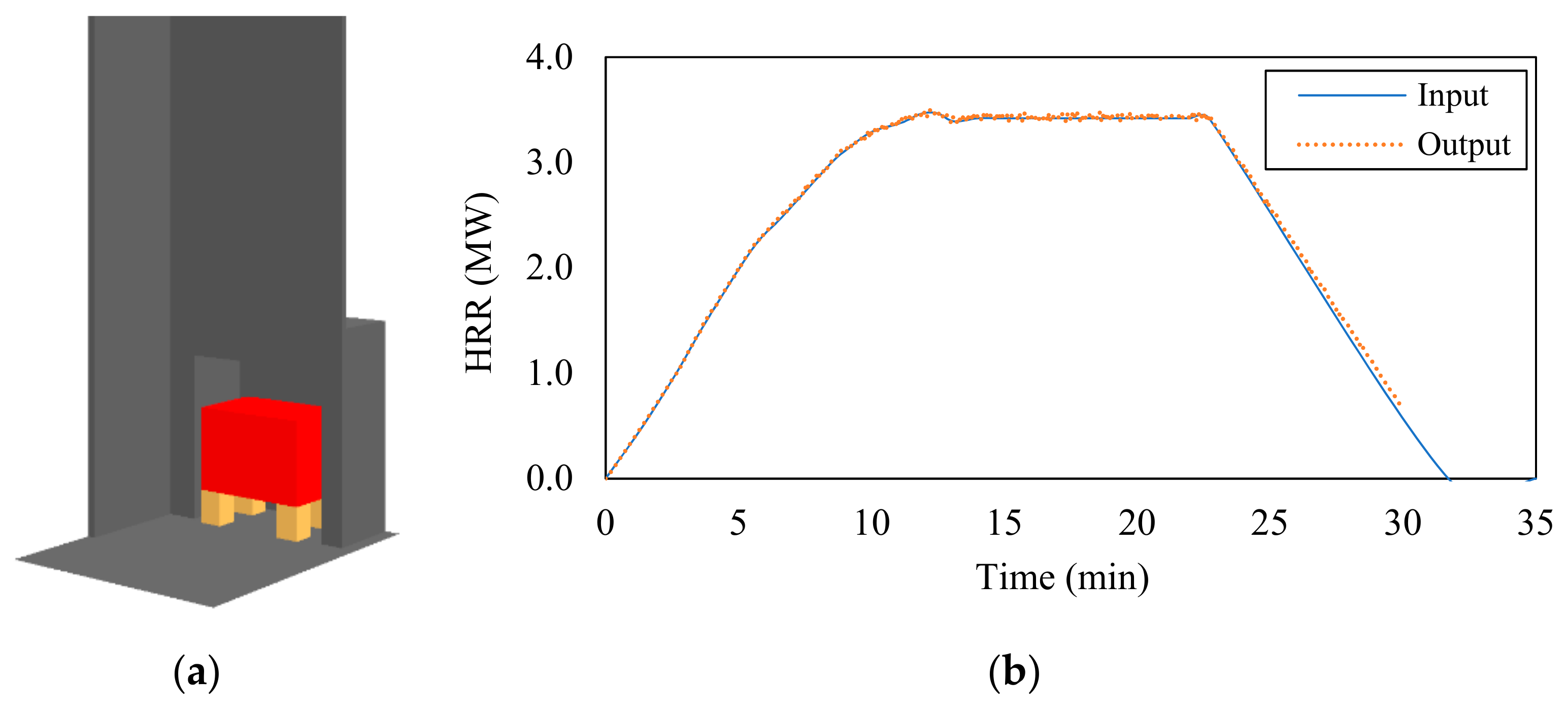
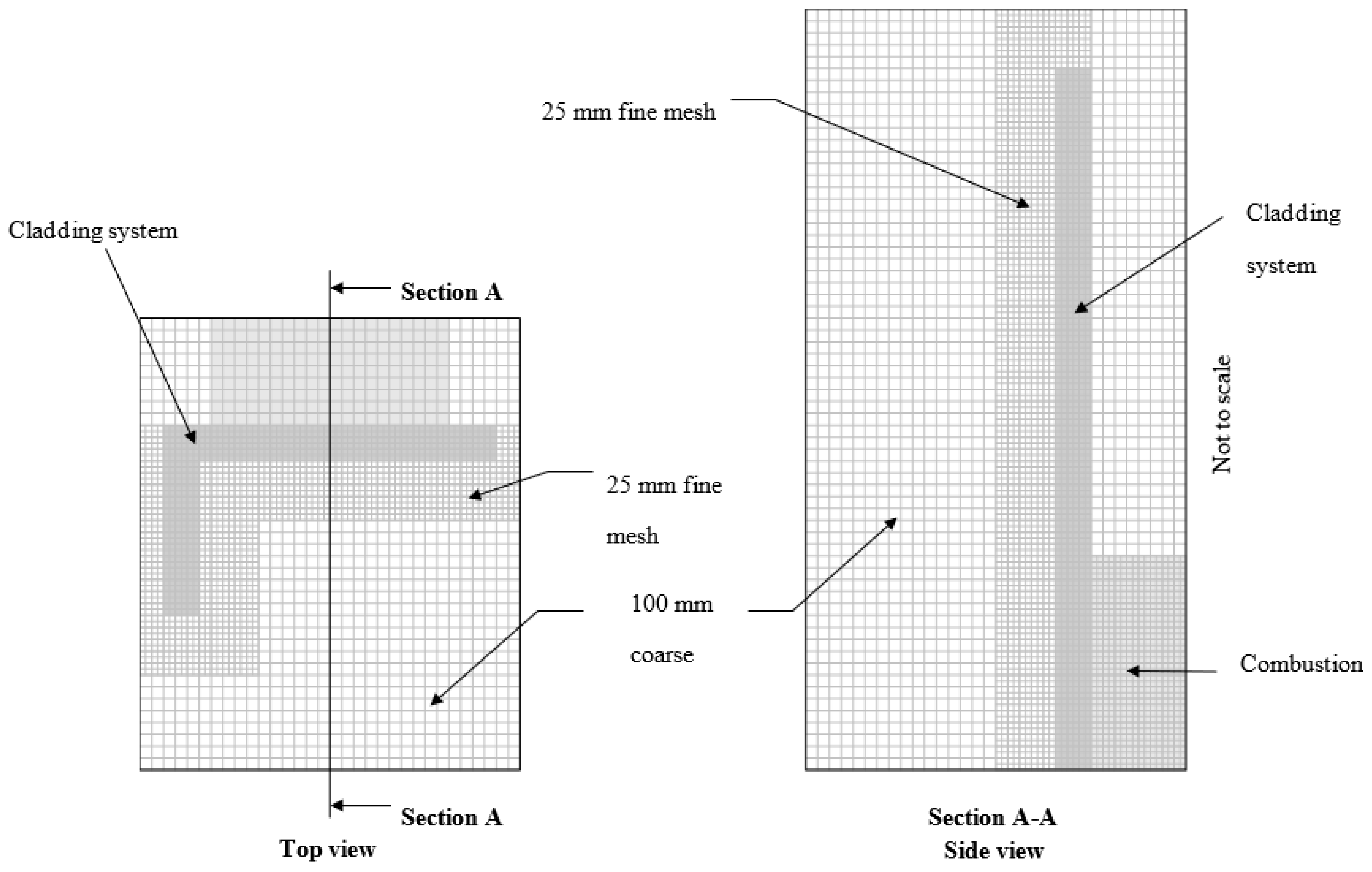
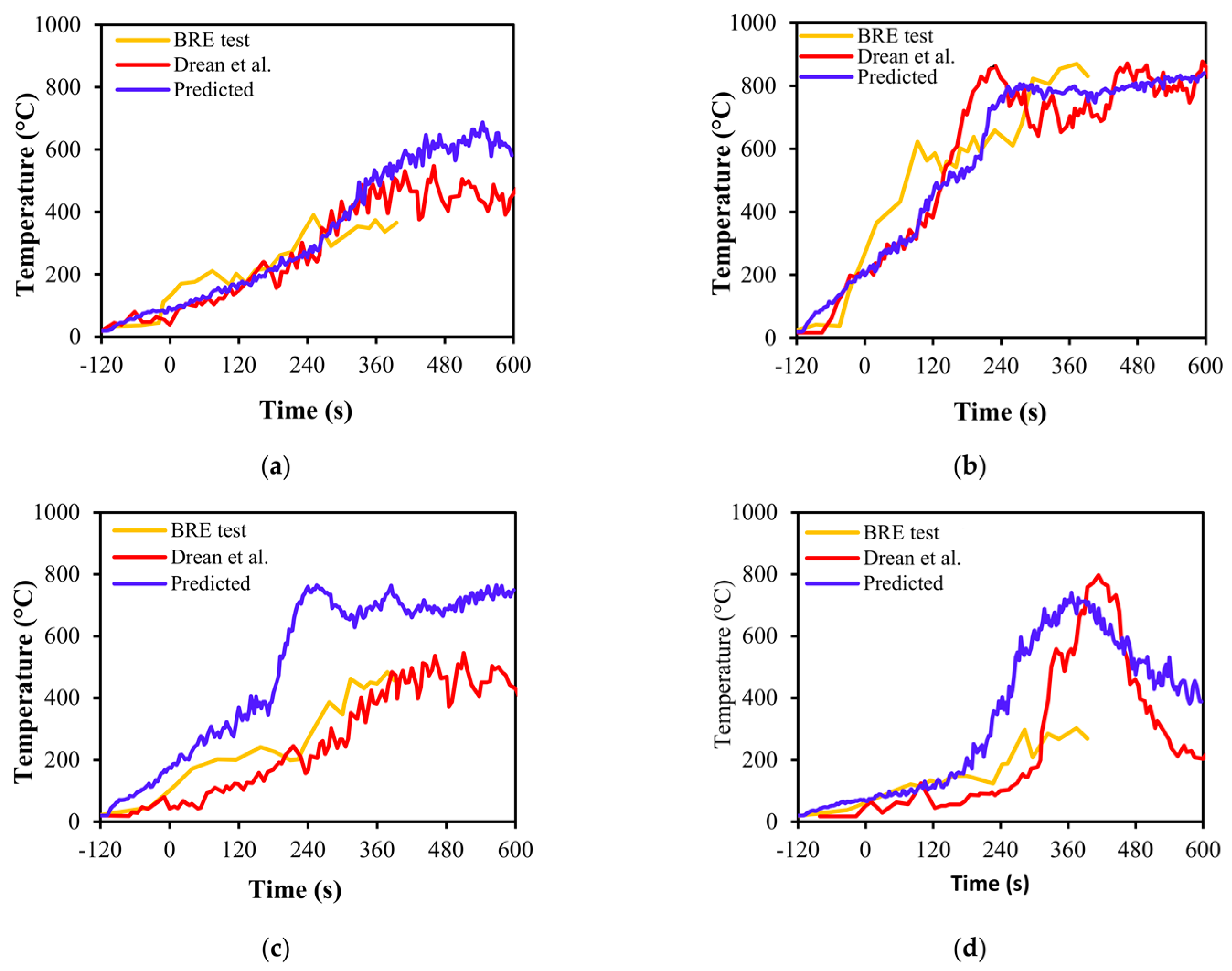
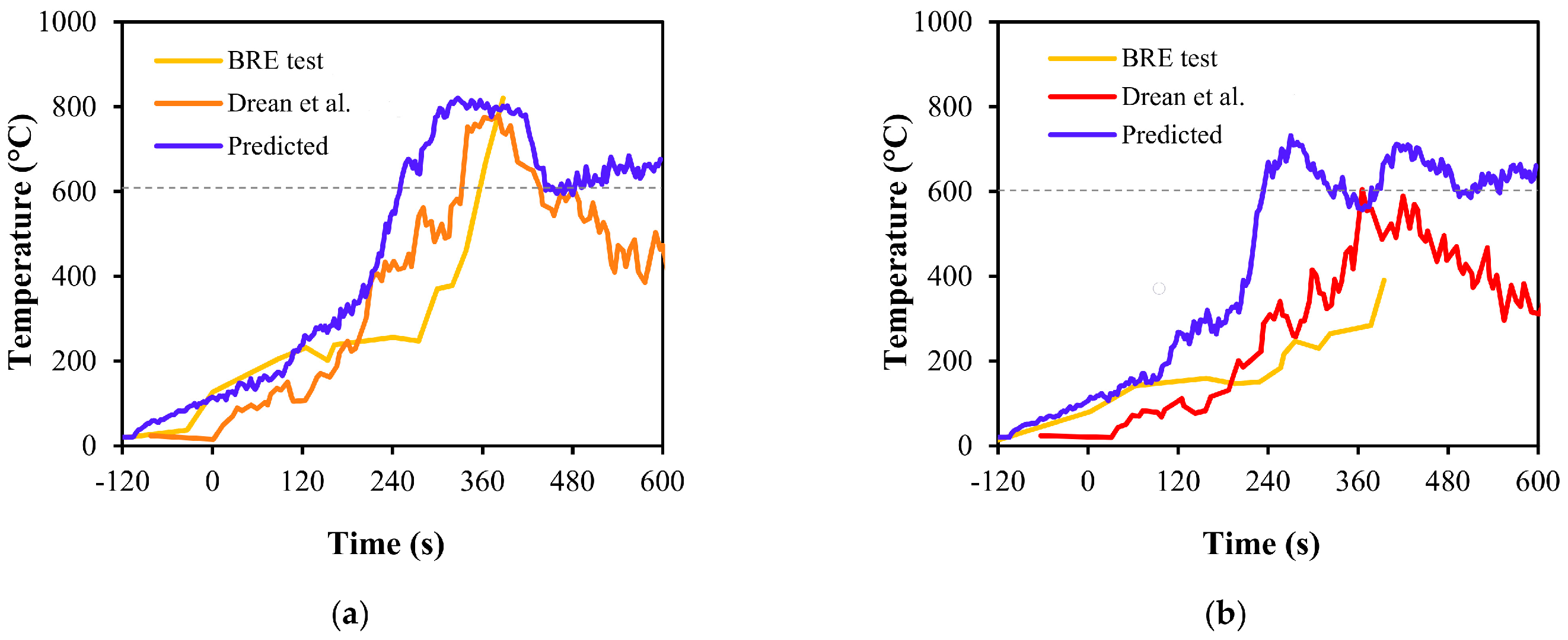
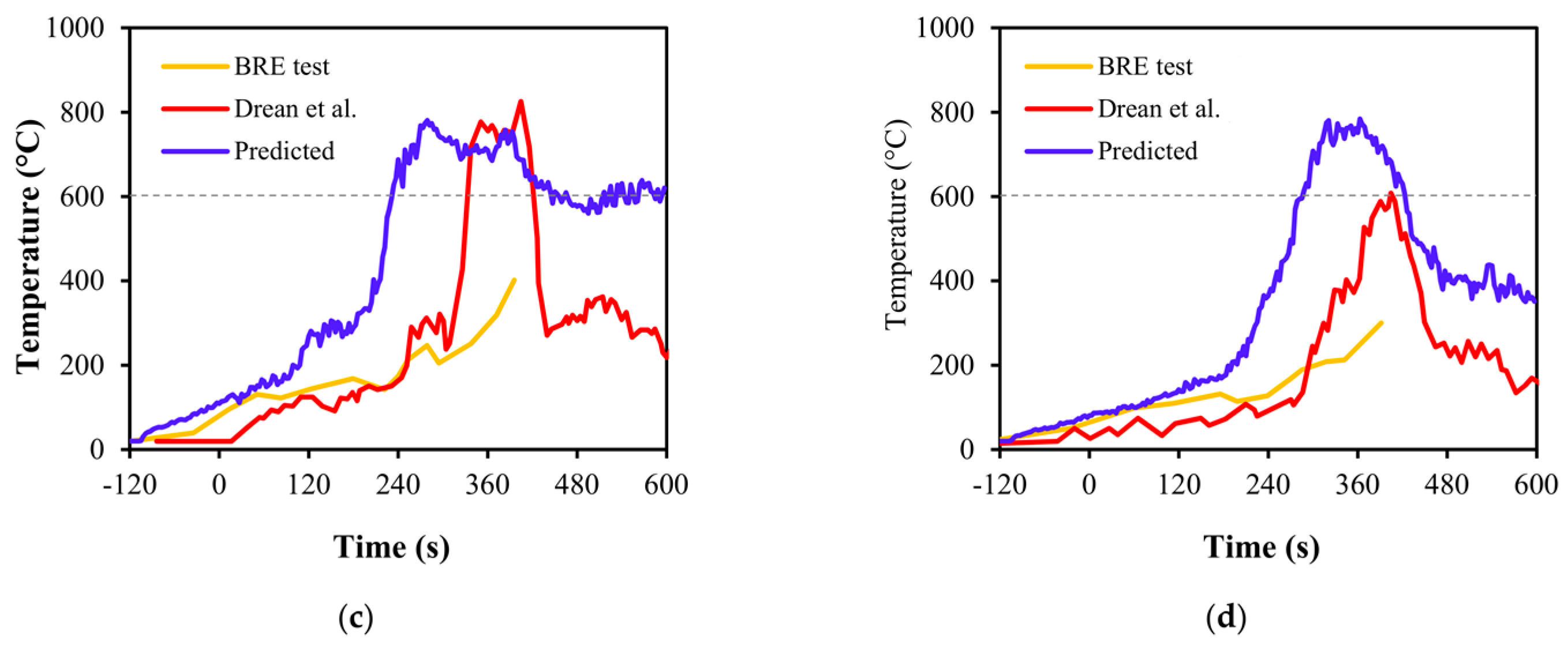
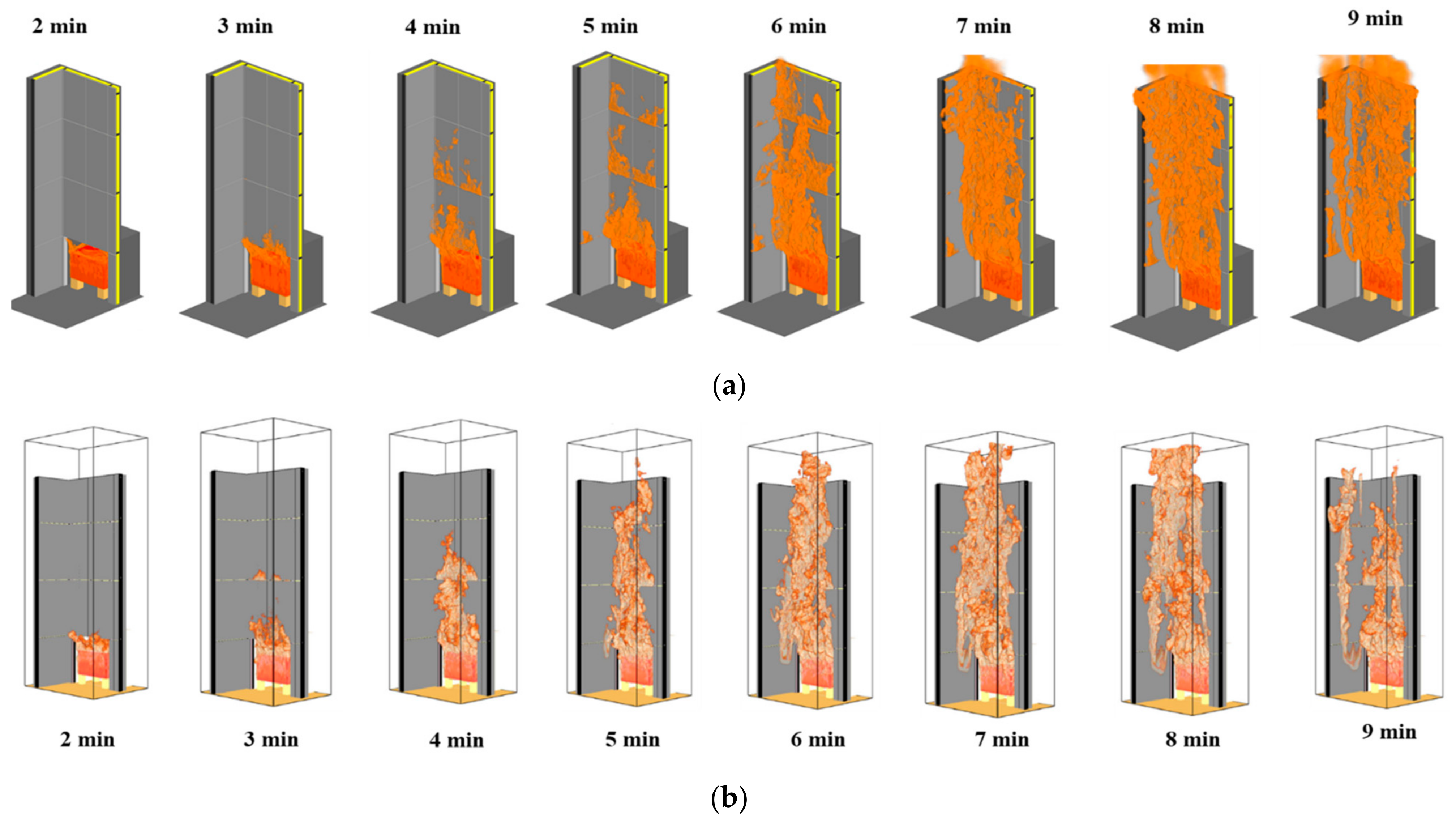
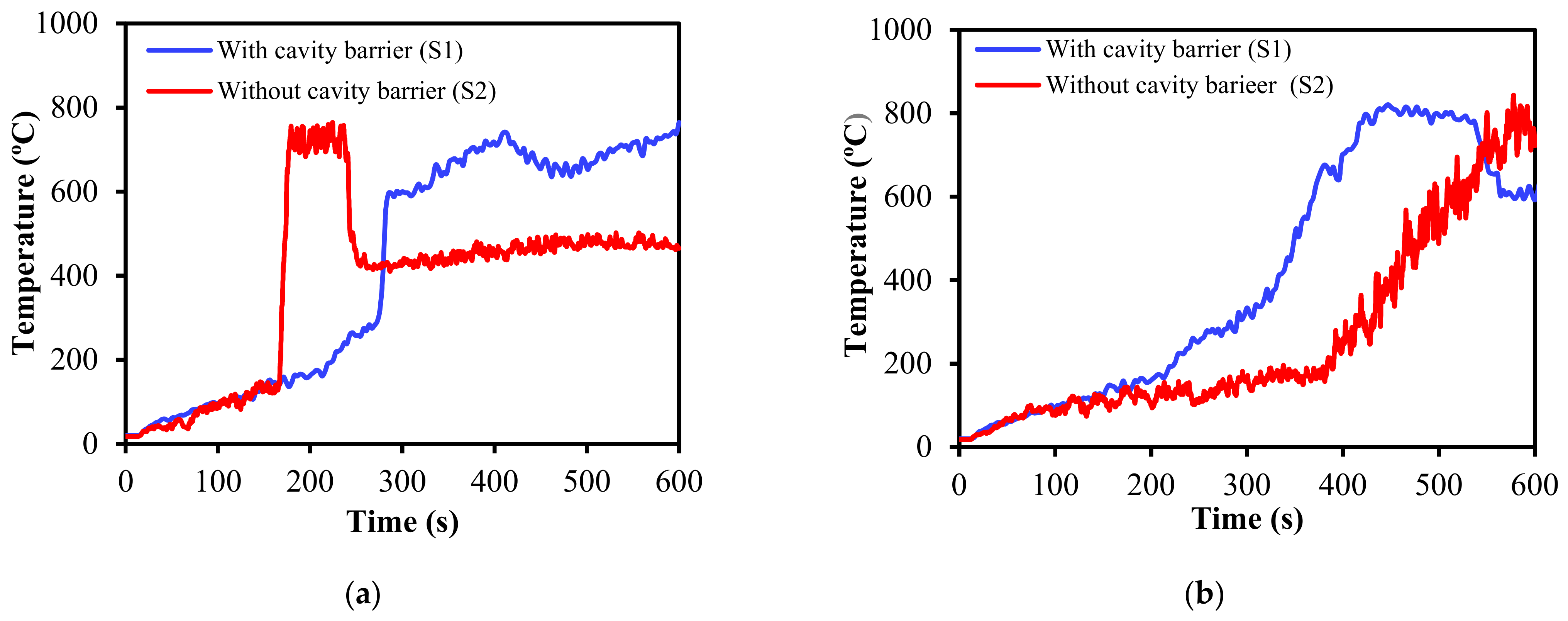
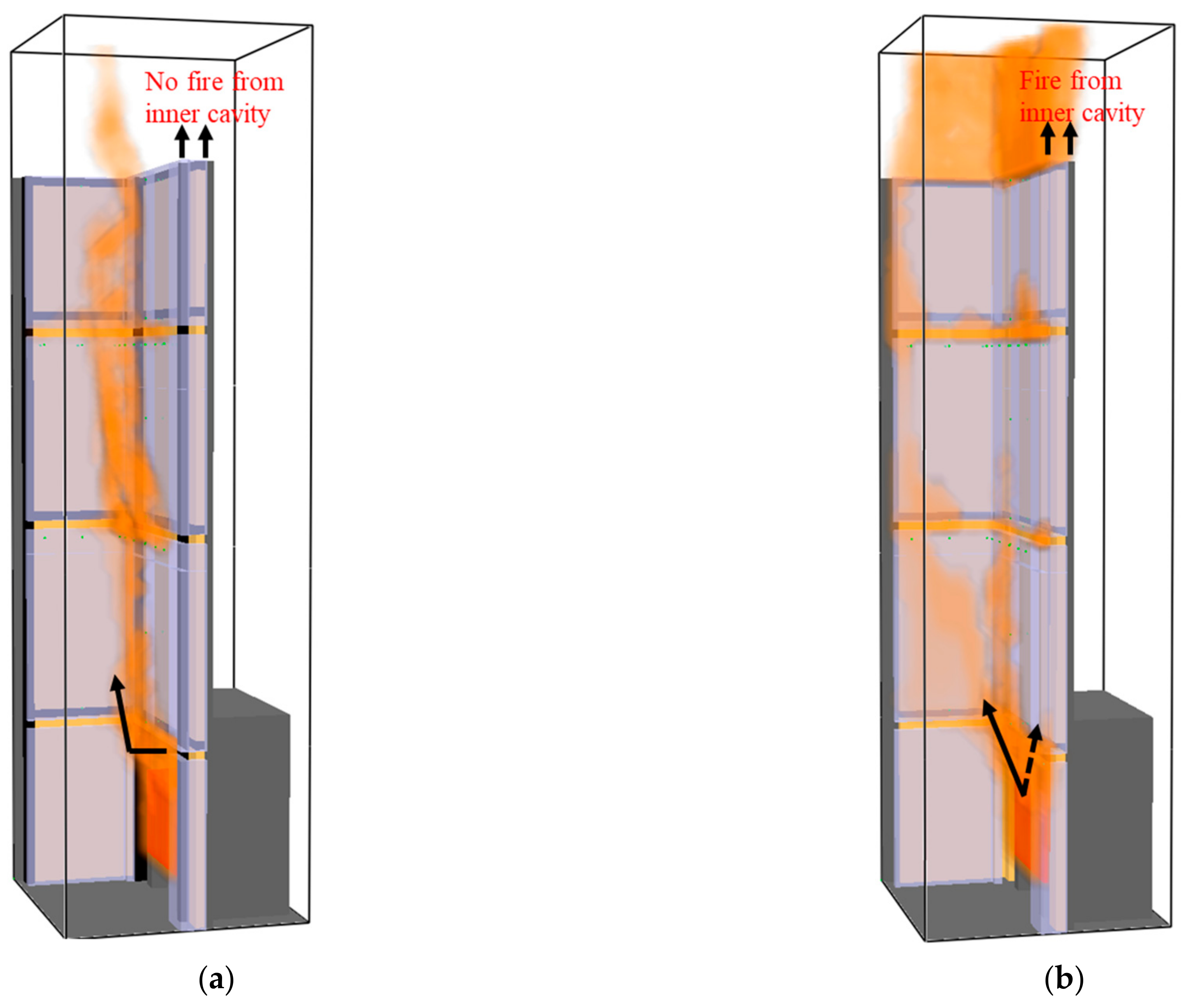
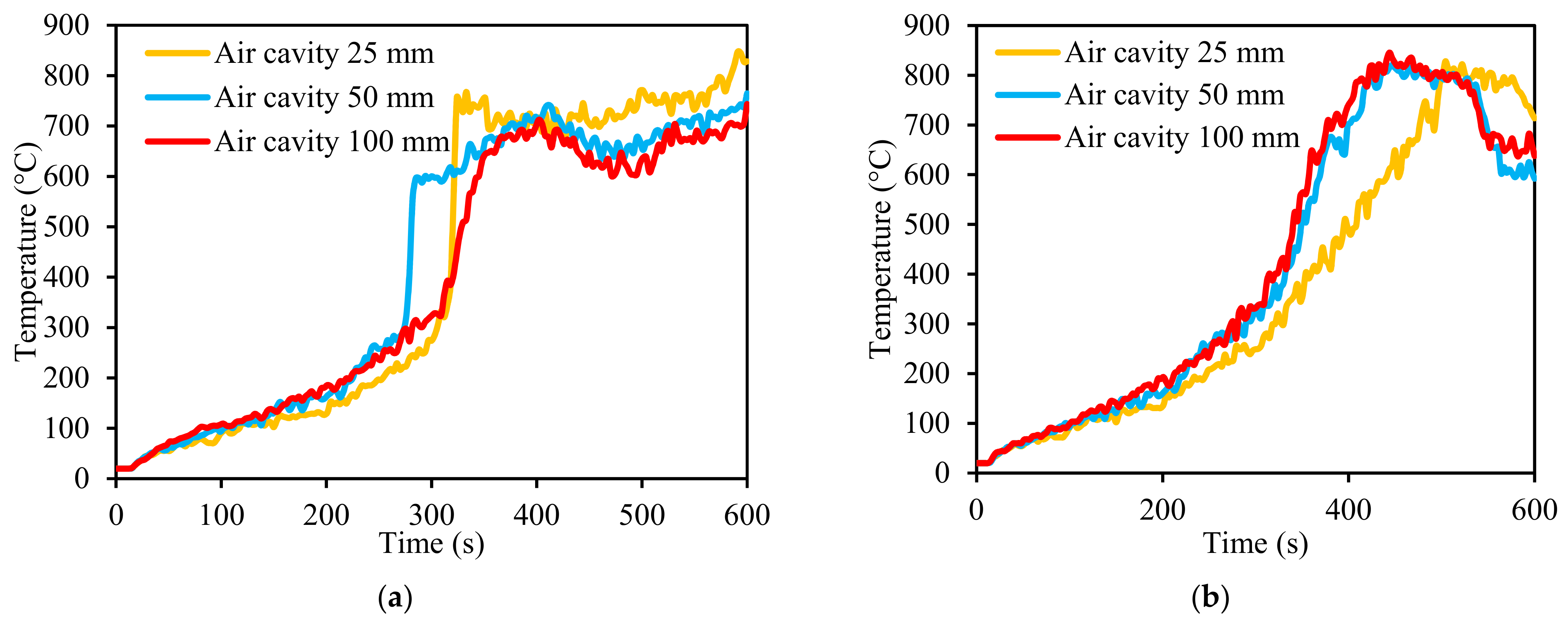
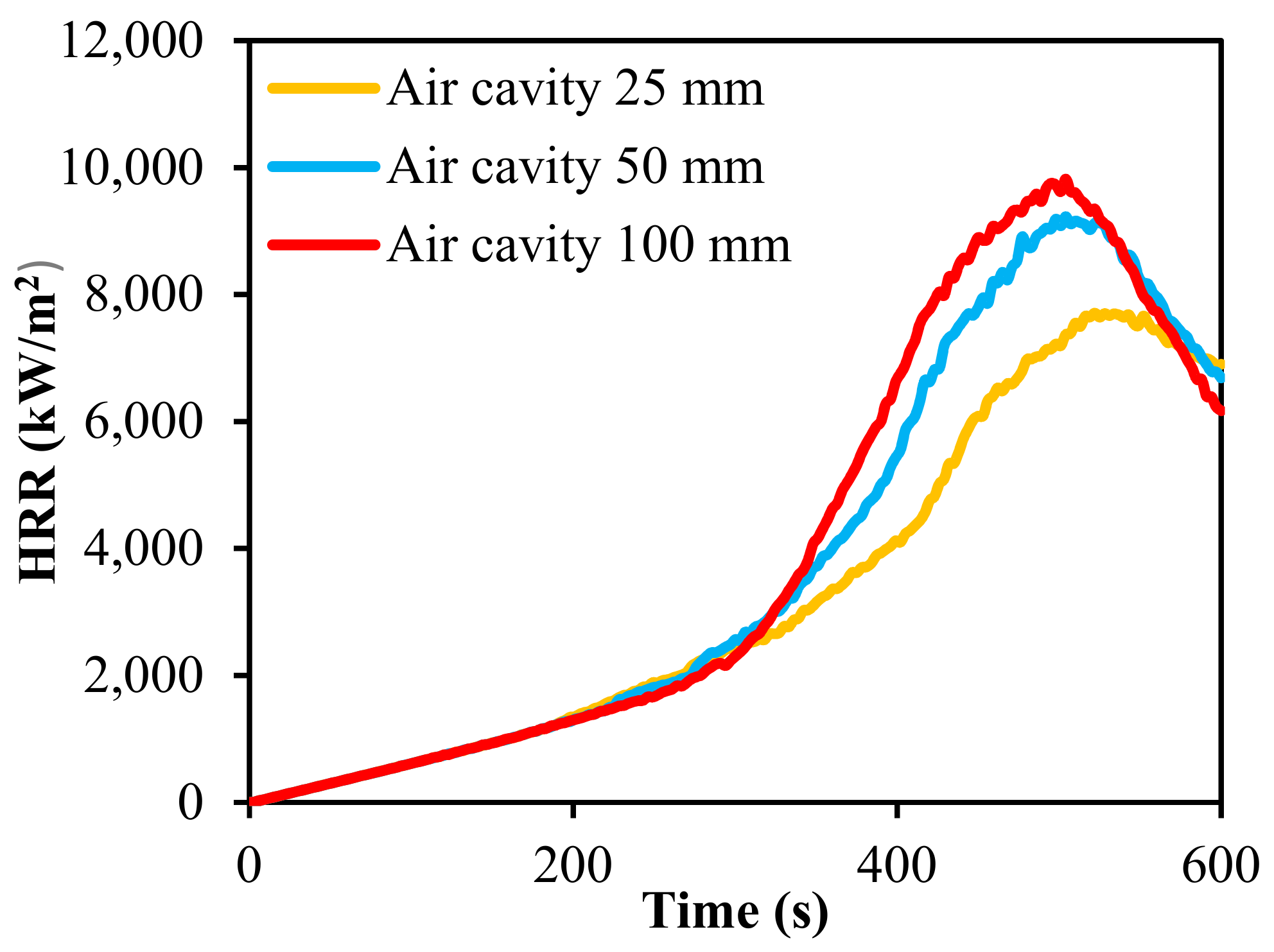
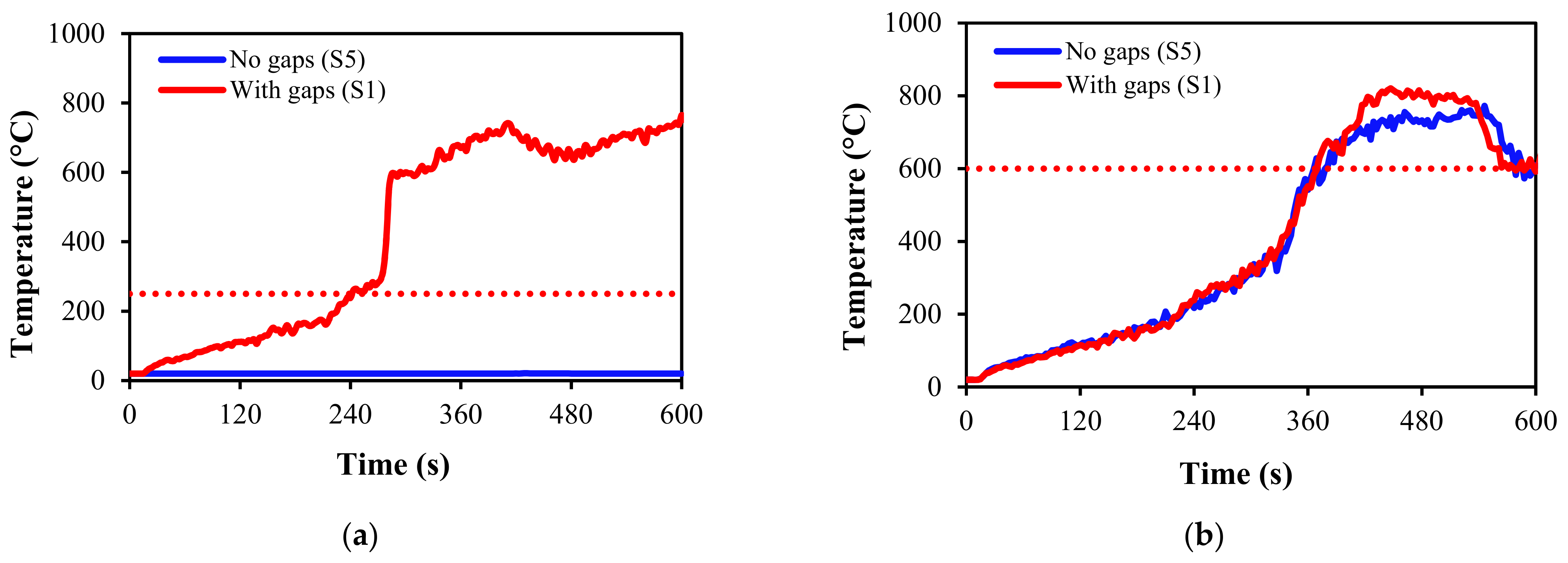
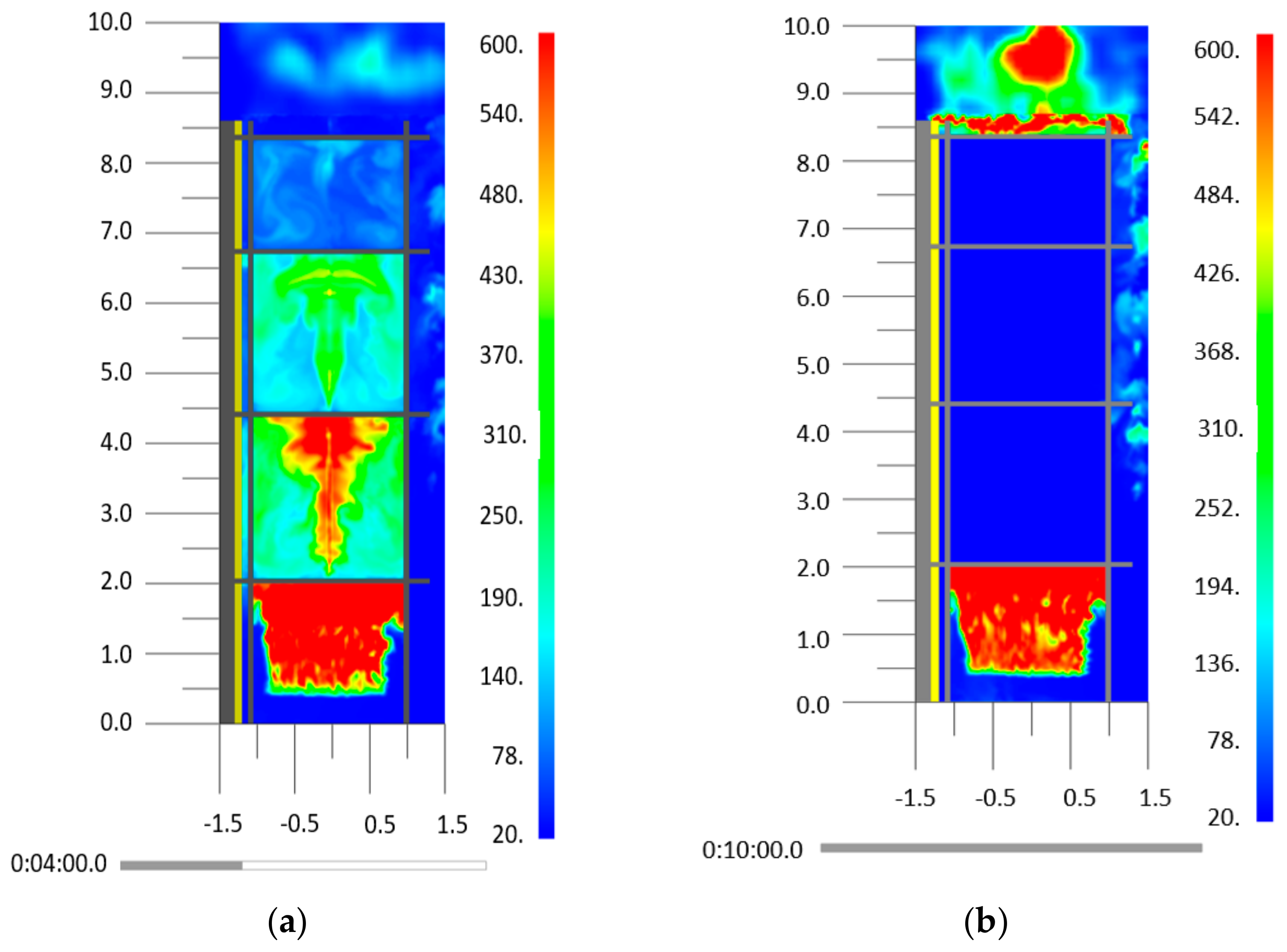
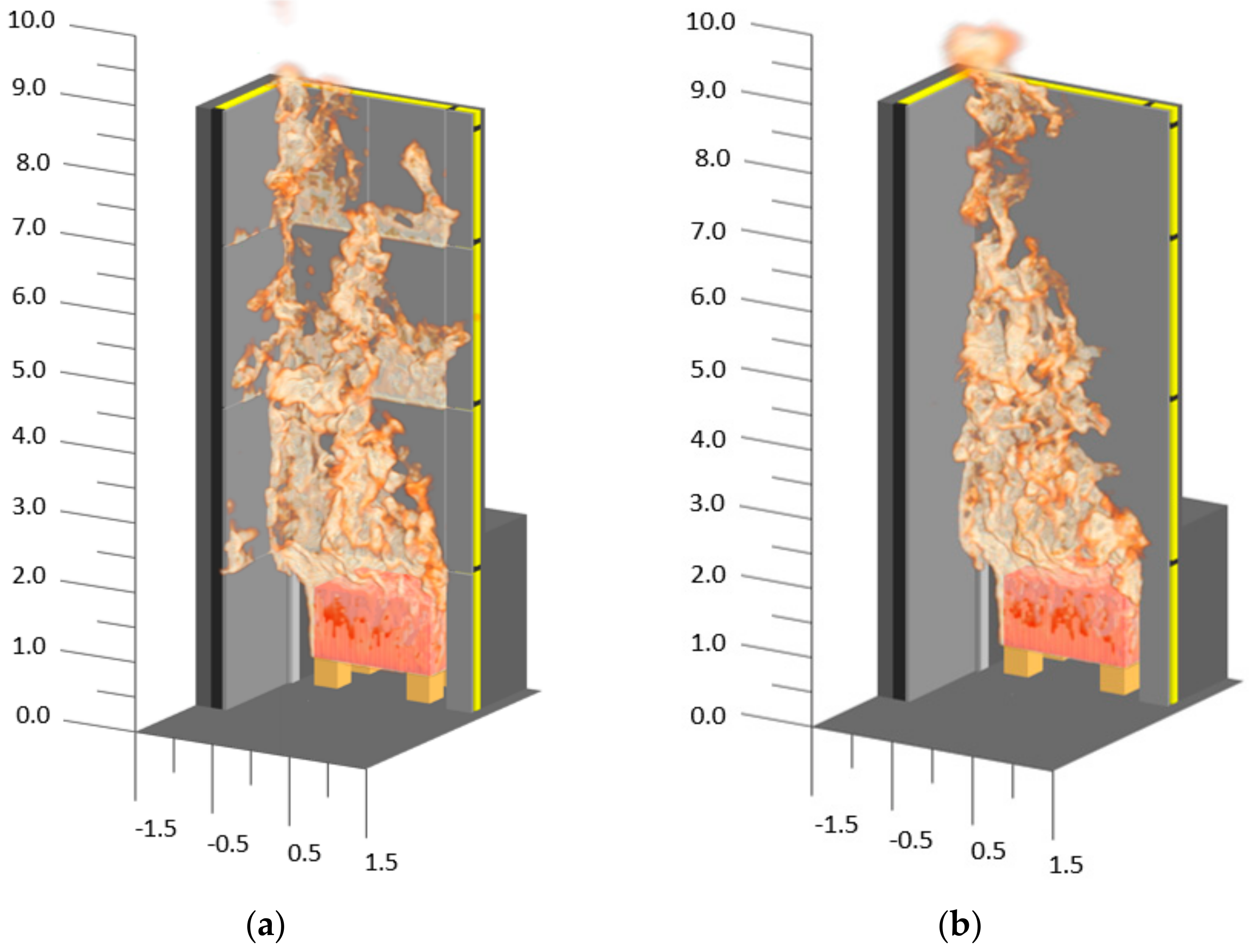
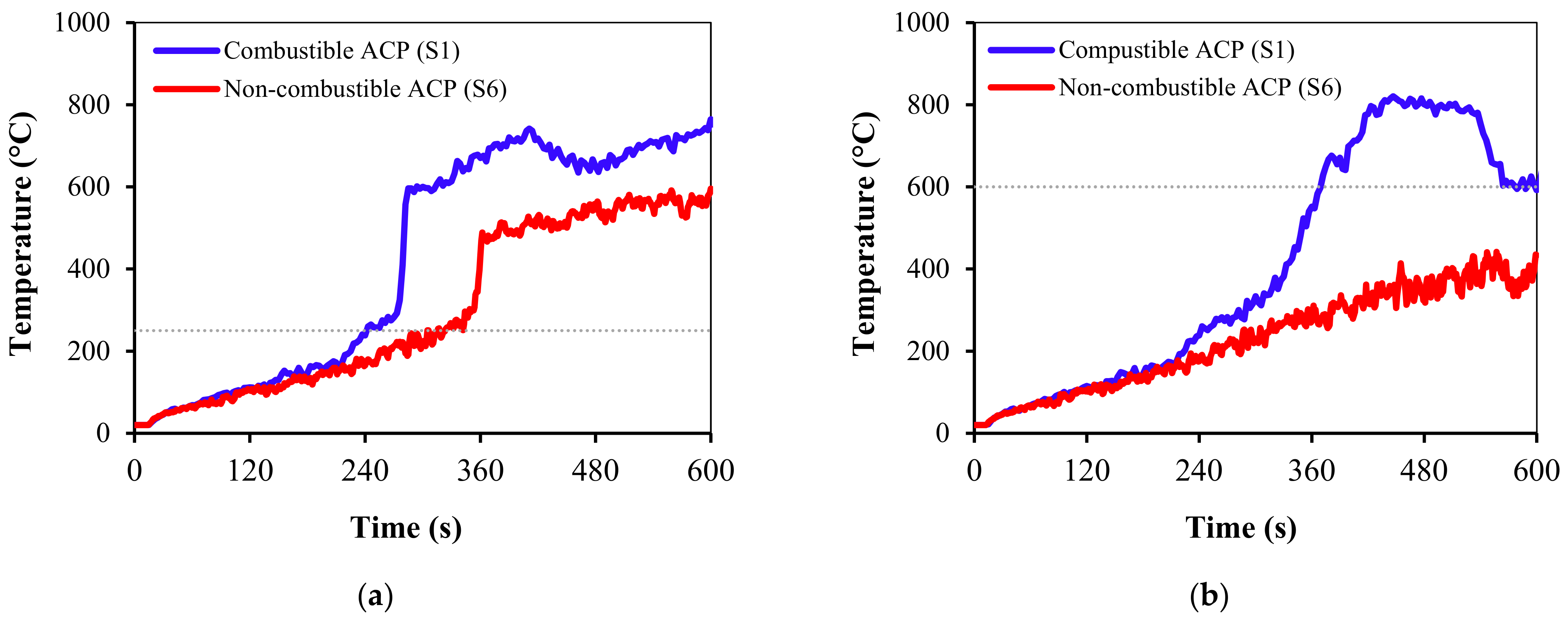
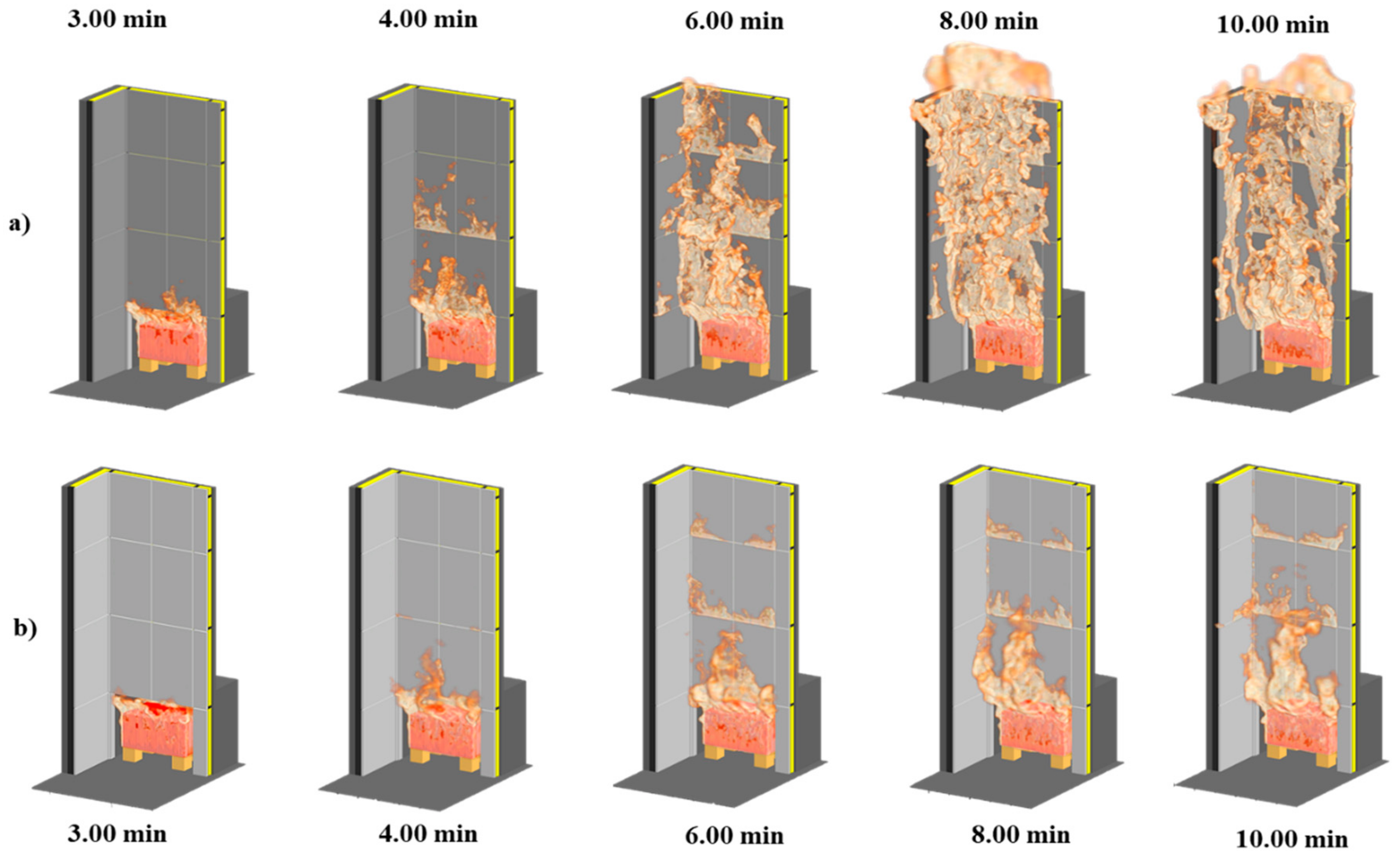
| Item | Description |
|---|---|
| Pyrolysis model | One-step decomposition reaction (Arrhenius equation) |
| Virgin → Char + Pyrolyzate | |
| Combustion model | Eddy dissipation concept model (EDC) |
| Infinitely fast chemical reaction | |
| For global combustion reaction | |
| Radiation model | Finite volume method (FVM), 100 discrete angles |
| Xrad, burner = 0.3 | |
| Turbulence model | Deardorff model |
| Convection model | |
| Meshing | 25 mm (material zones) and 50–100 mm (remote zones) |
| Materials | Input Properties | Ref. | ||||
|---|---|---|---|---|---|---|
| Cp (kJ/kg.K) | k (W/m.K) | ρ (Kg/m3) | ΔHc (kJ/kg) | ε | ||
| Polyethylene | 3.0 | 0.38 | 1360.0 | 4.35 × 104 | 0.92 | [20,21,22,23] |
| PIR | 1.1 | 0.048 | 36.0 | 2.63 × 104 | 1 | [19,20,21,22,23] |
| Aluminium | 0.9299 | 196.3 | 2700 | - | 0.7 | [21,24] |
| Concrete | 1.04 | 1.8 | 2280 | - | 0.9 | [21,22] |
| Scenario No | Joining Gap between Panels | Cavity Barrier | Air Cavity | Material Combustibility | Fire Load | |
|---|---|---|---|---|---|---|
| Vertical | Horizontal | |||||
| S1 | 25 mm | Yes | Yes | 50 mm | 100% | 3.5 MW |
| S2 | 25 mm | No | No | 50 mm | 100% | 3.5 MW |
| S3 | 25 mm | Yes | Yes | 25 mm | 100% | 3.5 MW |
| S4 | 25 mm | Yes | Yes | 100 mm | 100% | 3.5 MW |
| S5 | No * | Yes | Yes | 50 mm | 100% | 3.5 MW |
| S6 | 25 mm | Yes | Yes | 50 mm | 0% | 3.5 MW |
Publisher’s Note: MDPI stays neutral with regard to jurisdictional claims in published maps and institutional affiliations. |
© 2022 by the authors. Licensee MDPI, Basel, Switzerland. This article is an open access article distributed under the terms and conditions of the Creative Commons Attribution (CC BY) license (https://creativecommons.org/licenses/by/4.0/).
Share and Cite
Hassan, M.K.; Hossain, M.D.; Gilvonio, M.; Rahnamayiezekavat, P.; Douglas, G.; Pathirana, S.; Saha, S. Numerical Investigations on the Influencing Factors of Rapid Fire Spread of Flammable Cladding in a High-Rise Building. Fire 2022, 5, 149. https://doi.org/10.3390/fire5050149
Hassan MK, Hossain MD, Gilvonio M, Rahnamayiezekavat P, Douglas G, Pathirana S, Saha S. Numerical Investigations on the Influencing Factors of Rapid Fire Spread of Flammable Cladding in a High-Rise Building. Fire. 2022; 5(5):149. https://doi.org/10.3390/fire5050149
Chicago/Turabian StyleHassan, Md Kamrul, Md Delwar Hossain, Michael Gilvonio, Payam Rahnamayiezekavat, Grahame Douglas, Sameera Pathirana, and Swapan Saha. 2022. "Numerical Investigations on the Influencing Factors of Rapid Fire Spread of Flammable Cladding in a High-Rise Building" Fire 5, no. 5: 149. https://doi.org/10.3390/fire5050149
APA StyleHassan, M. K., Hossain, M. D., Gilvonio, M., Rahnamayiezekavat, P., Douglas, G., Pathirana, S., & Saha, S. (2022). Numerical Investigations on the Influencing Factors of Rapid Fire Spread of Flammable Cladding in a High-Rise Building. Fire, 5(5), 149. https://doi.org/10.3390/fire5050149













